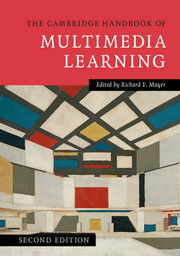Book contents
- The Cambridge Handbook of Multimedia Learning
- The Cambridge Handbook of Multimedia Learning
- Copyright page
- Contents
- Contributors
- Preface
- Acknowledgments
- 1 Introduction to Multimedia Learning
- Part I Theoretical Foundations
- Part II Basic Principles of Multimedia Learning
- Part III Advanced Principles of Multimedia Learning
- Part IV Multimedia Learning of Cognitive Processes
- 26 Multimedia Learning of Cognitive Processes
- 27 Multimedia Learning of Metacognitive Strategies
- 28 Multimedia Learning and the Development of Mental Models
- Part V Multimedia Learning in Advanced Computer-Based Contexts
- Author Index
- Subject Index
28 - Multimedia Learning and the Development of Mental Models
from Part IV - Multimedia Learning of Cognitive Processes
Published online by Cambridge University Press: 05 August 2014
- The Cambridge Handbook of Multimedia Learning
- The Cambridge Handbook of Multimedia Learning
- Copyright page
- Contents
- Contributors
- Preface
- Acknowledgments
- 1 Introduction to Multimedia Learning
- Part I Theoretical Foundations
- Part II Basic Principles of Multimedia Learning
- Part III Advanced Principles of Multimedia Learning
- Part IV Multimedia Learning of Cognitive Processes
- 26 Multimedia Learning of Cognitive Processes
- 27 Multimedia Learning of Metacognitive Strategies
- 28 Multimedia Learning and the Development of Mental Models
- Part V Multimedia Learning in Advanced Computer-Based Contexts
- Author Index
- Subject Index
Summary
This chapter examines how people use diagrams, models, animations, and multimedia presentations to learn about physical systems. Comprehension of these representations is analyzed within an information processing framework that specifies the cognitive processes involved in understanding external representations, including attention, encoding, inference, and the integration of different representations. The chapter first reviews the literature on the comprehension of physical systems from diagrams, animations, and models (both physical and virtual) alone and then reviews how people understand physical systems from multimedia presentations that combine these media and augment them with verbal instruction. The picture that emerges is that comprehension of media is an active process of knowledge construction rather than a passive process of internalizing the information presented in an external display. Because multimedia understanding depends on active information processing, it can be influenced considerably by the abilities, skills, and knowledge of the student. What is learned from media is jointly determined by aspects of the display and aspects of the learner.
Keywords
- Type
- Chapter
- Information
- The Cambridge Handbook of Multimedia Learning , pp. 673 - 702Publisher: Cambridge University PressPrint publication year: 2014
- 17
- Cited by

